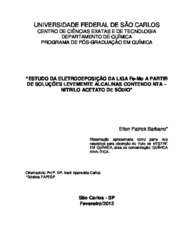Estudo da eletrodeposição da liga Fe-Mo a partir de soluções levemente alcalinas contendo NTA - Nitrilo Acetato de Sódio
Abstract
Fe-Mo alloys were electrochemically deposited on to a Pt substrate, from an alkaline solution containing FeCl3, Na2MoO4, trisodium nitrilotriacetic (NTA), in which Fe3+ ions were ddissolved to form [Fe(OH)(NTA)]-, [Fe(OH)2(NTA)]2- and [Fe(NTA)2]3- or [Fe2O(NTA)2]2- complexes, for NTA 0.110 mol L-1 or 0.055 mol L-1 in solution respectively. Voltammetric studies of Pt in the solution containing Fe and Mo salts and 0.110 mol L-1 NTA, led to suggest that [Fe(NTA)2]3- complex reduced to [Fe(NTA)2]4- and [Fe(OH)(NTA)]1- to [FeOH(NTA)]2- In addition it was proposed that the codeposition of Fe-Mo takes play only for more negative potentials than ~ -0,92V, im parallel to the hydrogen evolution reaction HER. However, in the presence of 0,055 mol L-1 NTA, only a cathodic peak c´ was seen, which corresponds to reduction of [Fe(OH)(NTA)]1- a [Fe(OH)(NTA)]2-. Also, it was proposed that only beyond this peak Fe and Mo codeposited in parallel to HER. However, only a cathodic peak was seen for the system Pt/Fe(III), Mo(IV), NTA 0.055 mol L-1 that corresponds to the reduction of [Fe(OH)(NTA)]- to [Fe(OH)(NTA)]2- and only beyond ~ -0,88 V, Fe and Mo codeposit simultaneously to HER. Voltammetric deposition of Fe and Mo at various rotating speeds of the Pt disk electrode showed that the reduction process was controlled by mass transport. Fe- Mo deposition potential (Ed) was varied and the morphology, chemical composition and phase composition of deposits were investigated. Scanning electron microscope (SEM) images of Fe-Mo deposits obtained at - Ed = - 2.10 V e -2.70 V, with Qd = 95.55 C cm-2 and both NTA concentrations, showed that, they were uniform and formed by coalesced globular crystallites. Moreover, for Ed = -2.10 V the globular crystallites were more refined. Also, for the latter with xii ABSTRACT NTA 0.110 mol L-1, the deposit was thinner that the other, due to more intense HER in this case. Energy dispersive spectroscopy (EDS) analysis of Fe-Mo deposit produced in the presence of NTA 0.110 mol L-1, with Qd = 95.55 C cm-2, showed that only in a more negative Ed than -1.30 V Fe and Mo codeposited. Nevertheless, in the presence of NTA 0.055 mol L-1, Fe and Mo codeposition occurred at Ed, more negative than -2.0 V. Furthermore, the presence of NTA 0.110 mol L-1, the codeposition occurs at Ed, more negative than -1.20 V. Thus, these results indicate that fe and Mo codeposition was inhibited in the presence of NTA 0.055 mol L-1, due to the presence of the ([Fe2O(NTA)2]2- complex in the bath. Oxygen incorporation in the electrodeposits occurred for both NTA concentrations, irrespective of the Ed, due to metallic hydroxide precipitation. X-ray diffraction spectroscopy (DRX) analyses of the Fe-Mo deposits produced at various Ed and with Qd = 95.55 C cm-2, irrespective of NTA concentrations, showed, in general, that they were formed of a phase mixture. Also, the deposit diffractograms obtained in the presence of NTA 0.055 mol L-1 showed broad diffraction peaks, which are characteristics of low crystalline structures. The presence of different phases, at each Ed, for both NTA concentrations, indicated that the nucleation process was dissimilar.
